Making Board Meetings Matter: From Routine to Strategic
Board meetings should be lively forums for insight, foresight, and decision making — yet too often, they fall flat. Instead of shaping the organization’s direction, meetings can devolve into staff updates and operational briefings. When the agenda is dominated by fiduciary topics like risk management, compliance, and financial reporting, there’s little room for the kind of forward-looking dialogue that fuels growth and innovation.
If your governance meetings feel more like progress reports than opportunities for leadership, it’s time to reframe how you use this valuable time. Effective governance happens when board members are engaged as thought partners — not passive recipients of information.
1. Start With Purpose, Not Paperwork
The most productive meetings begin with intention: What do we need the board to think about, decide, or weigh in on today? Provide concise pre-meeting materials that focus on key questions or decisions and give members time to reflect in advance. During the meeting, focus on discussion rather than presentation. Staff should briefly set the stage, then invite reflection, input, and consensus building.
2. Elevate Strategic Conversations
Every agenda should include at least one item that requires strategic thinking. Introduce topics that stretch perspectives — an emerging trend, a potential risk, or a growth opportunity — and use framing questions to spark engagement, such as:
“What external factors could significantly affect our ability to serve clients in the next two years?”
“If funding decreased by 20%, how would we maintain our mission impact?”
These types of discussions move the board from what happened to what should happen next.
3. Engage Every Voice
Meaningful participation doesn’t happen by chance. Encourage it like small-group discussions, round-robin sharing, or breakout prompts to draw out diverse perspectives. Invite specific members to lead parts of the agenda based on their expertise. When board members are asked to think, question, and contribute, they develop a sense of ownership — and ownership drives stronger governance.
4. Balance Fiduciary, Strategic, and Generative Work
Boards operate in three modes: fiduciary (oversight and compliance), strategic (planning and prioritizing), and generative (sense-making and innovation). The most effective meetings weave all three together. For example, when reviewing financials, go beyond the numbers to ask: “What story do these trends tell about where we’re headed?”
5. Craft the Agenda Around Outcomes
Instead of structuring the agenda by department reports (“Finance Update,” “Program Report”), design it around outcomes or actions (“Decision on FY26 Priorities,” “Discussion: Potential New Service Area”). Use verbs that inspire engagement — decide, discuss, explore, confirm — to clarify the purpose of each item and keep the conversation focused on results rather than routine updates.
6. Use a Consent Agenda to Streamline Routine Business
A consent agenda groups non-controversial or routine items such as approving minutes, renewing policies, or reviewing informational updates into a single motion for approval. These materials are distributed beforehand, allowing board members to review them in advance. At the meeting, all items on the consent agenda are approved together, freeing up valuable time for strategic dialogue. If any member wishes to discuss a specific item, it can simply be moved to the regular agenda for further consideration.
7. End With Clarity and Action
Close each meeting by summarizing key takeaways, decisions, and next steps — including who is responsible and how progress will be measured. This creates accountability and keeps the work moving forward between meetings.
The bottom line: Great governance isn’t about polished reports or perfect minutes. It’s about fostering curiosity, insight, and collaboration among those entrusted to guide the organization’s mission. When board meetings are designed for participation and purpose, they become what they were always meant to be — a catalyst for organizational excellence.
At Accreditation Guru, we help boards and leadership teams strengthen their governance practices through customized board development, governance training, and strategic planning facilitation. Whether you’re looking to reinvigorate your meetings, clarify roles and responsibilities, or align your board around a shared vision for impact, our experienced consultants can help your organization Prepare for Greatness™.
Contact us today and take the first step!


